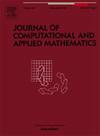A parallel domain decomposition-based implicit finite volume lattice Boltzmann method for incompressible thermal convection flows on unstructured grids
IF 2.1
2区 数学
Q1 MATHEMATICS, APPLIED
Journal of Computational and Applied Mathematics
Pub Date : 2025-02-22
DOI:10.1016/j.cam.2025.116578
引用次数: 0
Abstract
The double distribution function lattice Boltzmann method is known for its ability to handle various temperature changes and maintain strong numerical stability for incompressible thermal convection flows. However, being an explicit scheme on a Cartesian grid, it necessitates small time step sizes and limits its use in simulating fluid flows with intricate geometries. In this paper, a parallel fully implicit finite volume lattice Boltzmann method for incompressible thermal convection flows on unstructured grids is introduced. The double distribution function lattice Boltzmann equations are discretized by a finite volume method in space and an implicit backward Euler scheme in time. The resulting large sparse nonlinear system of algebraic equations is solved by a highly parallel Schwarz type domain decomposition preconditioned Newton–Krylov algorithm. The effectiveness of the proposed method is validated through five benchmark problems with a wide range of Rayleigh numbers: (a) porous plate problem with a temperature gradient, (b) natural convection in a square cavity, (c) natural convection in a concentric annulus, (d) mixed heat transfer from a heated circular cylinder and (e) nature convection in a sine-walled cavity. The numerical results demonstrate the robustness of the proposed method across all test cases, achieving a linear speedup in solving a problem with almost 40 million degrees of freedom using thousands of processor cores. The corresponding parallel efficiency reaches as high as 91.96% using 4096 processor cores.
非结构网格上不可压缩热对流流动的一种基于并行域分解的隐式有限体积晶格Boltzmann方法
双分布函数晶格玻尔兹曼方法以其处理各种温度变化的能力和对不可压缩热对流保持较强的数值稳定性而闻名。然而,作为笛卡尔网格上的显式格式,它需要较小的时间步长,限制了它在模拟复杂几何流体流动中的应用。本文介绍了一种求解非结构网格上不可压缩热对流的平行全隐式有限体积点阵玻尔兹曼方法。在空间上采用有限体积法,在时间上采用隐式后向欧拉格式对双分布函数晶格玻尔兹曼方程进行离散。采用高度并行的Schwarz型域分解预条件牛顿-克雷洛夫算法求解得到的大型稀疏非线性代数方程组。通过5个瑞利数范围较大的基准问题(a)具有温度梯度的多孔板问题,(b)方形腔体中的自然对流,(c)同心环空中的自然对流,(d)加热圆柱的混合传热和(e)正弦壁腔体中的自然对流)验证了所提方法的有效性。数值结果证明了该方法在所有测试用例中的鲁棒性,在使用数千个处理器内核解决近4000万个自由度的问题时实现了线性加速。使用4096个处理器核,相应的并行效率高达91.96%。
本文章由计算机程序翻译,如有差异,请以英文原文为准。
求助全文
约1分钟内获得全文
求助全文
来源期刊
CiteScore
5.40
自引率
4.20%
发文量
437
审稿时长
3.0 months
期刊介绍:
The Journal of Computational and Applied Mathematics publishes original papers of high scientific value in all areas of computational and applied mathematics. The main interest of the Journal is in papers that describe and analyze new computational techniques for solving scientific or engineering problems. Also the improved analysis, including the effectiveness and applicability, of existing methods and algorithms is of importance. The computational efficiency (e.g. the convergence, stability, accuracy, ...) should be proved and illustrated by nontrivial numerical examples. Papers describing only variants of existing methods, without adding significant new computational properties are not of interest.
The audience consists of: applied mathematicians, numerical analysts, computational scientists and engineers.

 求助内容:
求助内容: 应助结果提醒方式:
应助结果提醒方式:


